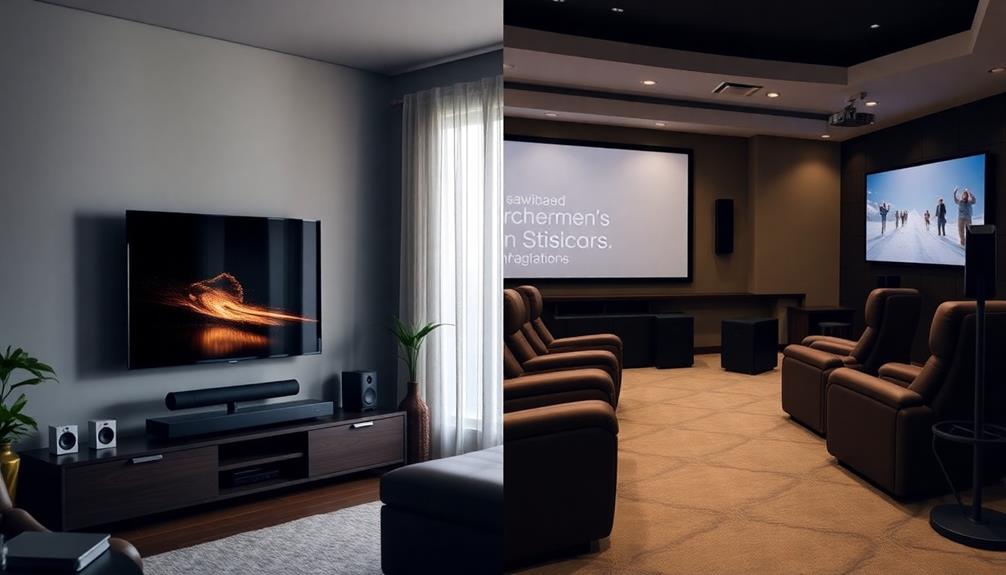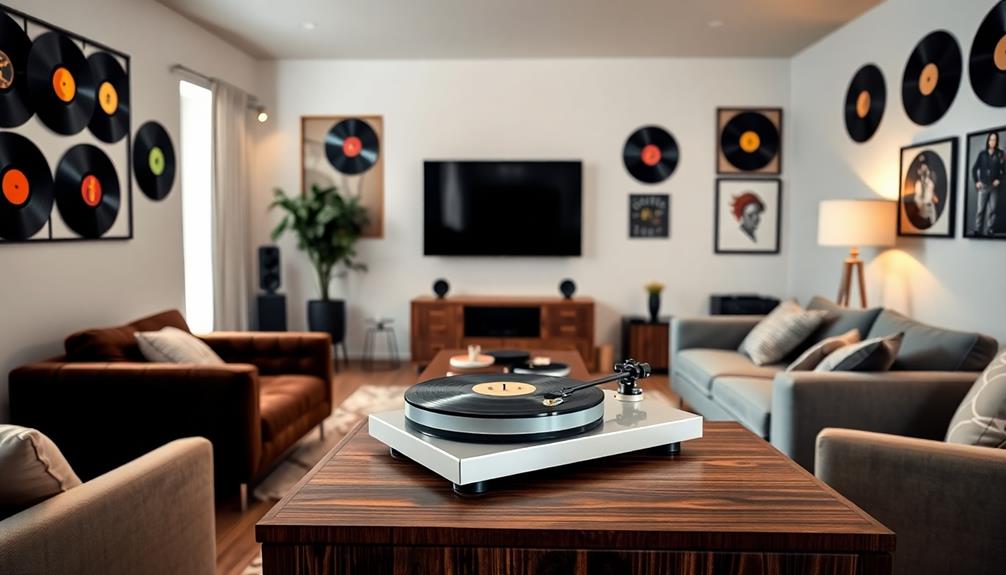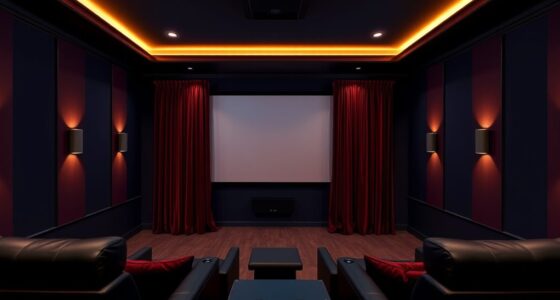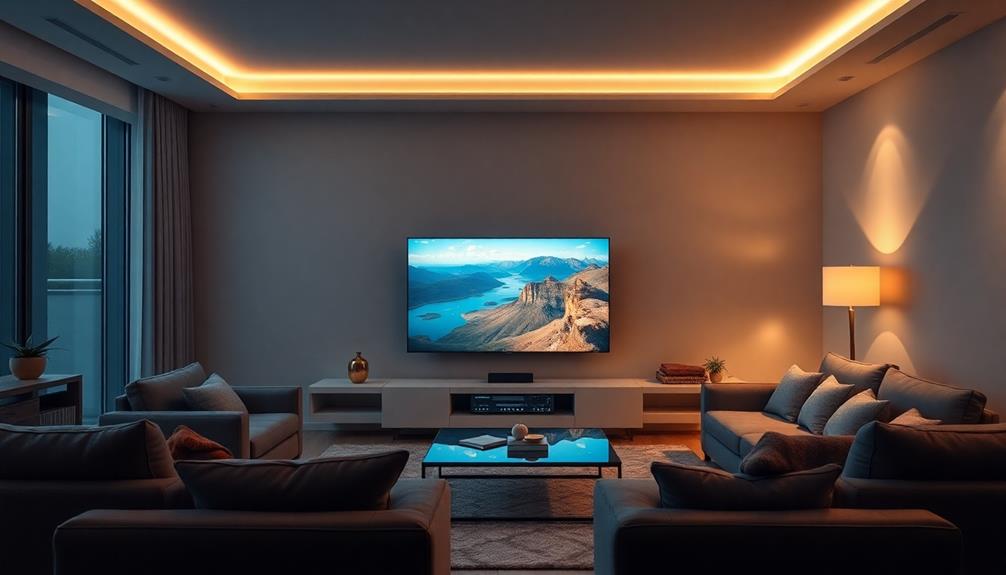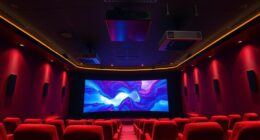Projectors can have various issues like a blank screen, poor image quality, or overheating. To fix a blank screen, check your connections and inspect the lamp. For image quality, clean the lens and adjust focus settings. If your projector shuts down, verify proper ventilation and clean air filters. A noisy fan often means dust buildup; regular cleaning helps. When the remote doesn't work, replace the batteries and clear obstructions. Finally, check for connectivity problems by verifying secure cables. If you want to troubleshoot further or discover more solutions, keep exploring the details on common projector problems and fixes!
Key Takeaways
- Check and secure all cable connections to resolve connectivity problems and prevent signal loss.
- Clean projector lens and air filters regularly to maintain image quality and prevent overheating.
- Adjust focus and keystone settings for clear and properly aligned images.
- Replace batteries in the remote control and ensure no obstructions are blocking the signal.
- Monitor projector for overheating by ensuring proper ventilation and allowing cooling breaks.
No Image or Blank Screen

If you're facing a frustrating issue with no image or a blank screen on your projector, don't worry—there are several straightforward steps you can take to troubleshoot the problem.
First, check the input source connections. Make sure they're secure and that you've selected the correct source on your projector. If those connections are fine, look at the lamp or LED bulb. A burnt-out bulb can lead to no image being projected, so inspect it for any signs of wear or failure.
Additionally, consider the environment where the projector is used; dust accumulation can hinder performance, similar to how regular cleaning is essential for peak performance of air purifiers.
Next, take a moment to inspect the projector lens. Dirt, dust, or smudges can obstruct the image, and a quick clean with a microfiber cloth might be all you need to fix the projector.
Don't forget to verify your projector is receiving proper power. Confirm that it's turned on and not stuck in standby mode, which you can check by looking at the status LED light.
Poor Image Quality

If you're facing poor image quality, start by adjusting the focus settings on your projector to guarantee sharp visuals.
Additionally, verifying that your projector supports features like HDR support can enhance the color depth and contrast of the image.
Don't forget to clean the lens regularly, as dust and smudges can severely impact clarity.
Making these simple adjustments can lead to a significant improvement in your viewing experience.
Adjusting Focus Settings
Adjusting focus settings is vital for achieving a sharp and clear image from your projector. Start by locating the focus ring on the projector lens. If the image appears fuzzy, turn the focus ring while observing the projected image until it achieves the desired sharpness.
Ensure that the projector resolution matches the output resolution of your source device. This alignment helps in enhancing focus and clarity. For ultra short throw projectors, proper alignment with the screen is essential, as incorrect positioning can greatly impact focus and overall image quality.
Here's a quick reference table to help you troubleshoot focus issues:
| Issue | Action | Result |
|---|---|---|
| Image appears fuzzy | Adjust the focus ring | Sharp, clear image |
| Poor resolution | Match projector and source resolution | Enhanced clarity |
| Misalignment | Reposition projector correctly | Improved focus |
| Blurry edges | Fine-tune focus settings | Clearer image edges |
| Incorrect settings | Reset projector settings | best display settings |
Cleaning Lens Regularly
Regularly cleaning your projector lens is essential for maintaining peak image quality. Dust, fingerprints, and smudges can lead to blurriness or distortion, which are common projector problems.
Just like using essential oils for toothache relief can improve discomfort, keeping your projector lens clean can enhance your viewing experience.
To keep your images sharp and vibrant, follow these simple steps:
- Turn off and cool down: Always verify your projector is powered off and cool before cleaning. This protects both your safety and the projector's components.
- Use the right tools: Grab a microfiber cloth or a lens brush specifically designed for optical surfaces. These tools will gently clean the lens without scratching it.
- Establish a cleaning routine: Aim to clean the lens at least once a month, or more frequently if you're in a dusty environment. This prevents buildup that can affect performance and helps maintain peak image quality.
Overheating and Shutdown

Overheating in projectors can lead to frustrating shutdowns, often triggered by blocked air vents or a failing cooling fan. To prevent overheating, you need to guarantee your projector has adequate ventilation. Keep those air vents clear, and maintain a cool ambient temperature while it's in use.
Regularly cleaning the air filters and the areas surrounding your projector can greatly enhance airflow and cooling efficiency. Dust accumulation can obstruct airflow, making it hard for the cooling fan to do its job.
If your projector shuts down due to overheating, turn it off, unplug it, and let it cool for at least 30 minutes before restarting.
Also, consider the room temperature and placement. Position your projector in a well-ventilated area to reduce the risk of overheating issues. Avoid placing it in tight spaces or near heat sources, as this can compromise its performance.
Noisy Fan

If your projector's fan is making a racket, it's likely due to dust buildup or wear and tear.
You can tackle this issue by regularly cleaning the fan and checking for any damage.
Let's explore some effective solutions to reduce that annoying noise and enhance your viewing experience.
Causes of Noisy Fan
A noisy fan in your projector can be a frustrating distraction, especially during an important presentation or movie night. Understanding the causes of this projector issue can help you find a solution. Here are three common reasons why your fan might be noisy:
- Dust and Debris: Accumulated dust can obstruct airflow, forcing the fan to work harder than necessary. Regular cleaning is essential to maintain ideal performance.
- Worn Bearings: Over time, fan bearings may wear down, leading to increased noise. If you notice this, replacing the fan can restore quiet operation.
- Poor Ventilation: Operating your projector in a poorly ventilated area can elevate its internal temperature. This causes the fan to work harder, generating more noise due to airflow resistance.
If your fan produces grinding or rattling noises, it might signal a mechanical failure. Immediate inspection and potential replacement are vital to prevent further damage.
Solutions for Noise Reduction
To reduce noise from your projector's fan, start by regularly cleaning the fan and surrounding areas to eliminate dust buildup. Dust can accumulate and considerably increase noise levels, making your viewing experience less enjoyable.
Next, inspect the fan for any signs of damage or excessive wear. A malfunctioning fan can contribute to increased noise, so it's vital to address any issues promptly.
If you've cleaned and inspected the fan but it remains excessively noisy, consider replacing it with a new one. A well-functioning fan is important for quiet operation.
Additionally, positioning the projector further away from your seating area can help minimize the perception of fan noise during use.
Remote Control Problems

Remote control problems can be frustrating, but there are straightforward solutions to get things back on track. Start by addressing the most common issues that might be causing the frustration.
- Replace the Batteries: First, swap out the old batteries for fresh ones, making sure they're inserted correctly according to polarity. You'd be surprised how often this simple fix solves the problem.
- Check for Obstructions: Next, look for any obstructions between your remote control and the projector's sensor. Even small items like paper or decorations can interfere with the signal, so clear the line of sight.
- Clean the Sensors: If the remote's still unresponsive, clean the sensors on both the remote and the projector. Dust and grime can build up, affecting functionality.
If you've tried these steps and still face issues, test the remote with another compatible device. This will help you determine if the problem lies with the remote or the projector itself.
Keystone Distortion

After troubleshooting remote control issues, you might encounter keystone distortion with your projector. This occurs when the projector isn't aligned properly with the screen, causing the image to appear trapezoidal instead of rectangular. To address this, you can use the keystone correction settings found in the projector's menu, which allow you to adjust the image alignment.
However, it's essential to guarantee proper positioning of the projector. Ideally, it should be set up perpendicular to the screen on a flat surface to minimize distortion. Uneven angles can exacerbate the problem, so take a moment to check your setup.
Here's a quick reference table for correcting keystone distortion:
| Issue | Solution |
|---|---|
| Trapezoidal Image | Adjust keystone correction settings |
| Projector Misalignment | Reposition the projector |
| Uneven Surface | Place projector on a flat surface |
| After Moving Projector | Recalibrate keystone settings |
Regularly recalibrating these settings can help maintain image quality, especially after moving the projector or changing its angle. By following these steps, you can achieve a clear and properly aligned image on your screen.
Color and Alignment Issues

When you're watching a movie or giving a presentation, color and alignment issues can really detract from the experience.
Fortunately, you can address these problems with a few simple steps.
- Calibrate Color Settings: Regularly adjust your projector's color settings to guarantee accurate representation. Don't forget to check the source device's color output as well.
- Use Keystone Correction: If the image appears skewed or distorted, use the keystone correction feature to realign the picture. This can dramatically improve how the content looks.
- Monitor Color Accuracy: Test with various content types to see if color accuracy issues are consistent or specific to certain media. Adjusting the balance and saturation settings can help maintain image quality over time.
If you notice persistent color imbalances after you've made these adjustments, inspect the projector's color wheel for potential faults.
In some cases, seeking professional repair services might be your best option.
Connectivity Problems

When you're dealing with connectivity problems, the first step is to guarantee all cable connections are secure.
Next, check if your input source is compatible with the projector, as unsupported formats can cause issues.
Don't forget to update any necessary firmware or drivers for peak performance.
Secure Cable Connections
Many projector issues stem from poor cable connections, so it's essential to verify that all cables are securely plugged in. Loose or damaged cables can lead to signal loss or image interruptions, causing frustration during your presentations or movie nights.
Here's how to guarantee secure cable connections:
- Inspect Cables: Check each cable for visible damage or bent pins. Replace any faulty cables to maintain a clear connection.
- Match Input Source: Confirm that the input source selected on the projector matches the video source you're connecting, whether it's HDMI, VGA, or another type. A mismatched input can prevent the projector from displaying anything at all.
- Use Quality Cables: Opt for high-quality cables, especially if you're connecting devices over longer distances. This minimizes potential interference and helps maintain a stable connection.
After making any changes, restart both the projector and the source device. This refreshes the signal and can resolve lingering connectivity issues.
Compatibility Verification
Guaranteeing compatibility between your projector and source device is essential for a smooth viewing experience. To avoid connectivity issues, always verify that the cables and adapters you're using are compatible with both your projector and the source device.
Here's a quick checklist to help you troubleshoot:
| Check | Action |
|---|---|
| Input Source | Confirm the correct input source is selected on your projector (e.g., HDMI, VGA). |
| Connection Points | Inspect all connection points for damage or looseness that might disrupt the signal. |
| Resolution Settings | Make sure your projector supports the resolution settings of the source device. |
If you're using an HDMI splitter or adapter, verify it's compatible with your projector's resolution and refresh rate. Additionally, keep in mind that outdated drivers on your source device can lead to connectivity failures. Regularly update your software drivers to prevent these issues. By following these steps, you'll enhance your viewing experience and minimize potential disruptions.
Firmware and Driver Updates
Regularly updating firmware and drivers for your projector and connected devices can greatly reduce connectivity problems. Keeping everything up to date not only resolves many connectivity issues but also enhances compatibility across devices.
Here's how you can guarantee smooth operation:
- Check for firmware updates: Regularly visit the manufacturer's website to find the latest firmware updates. These updates can fix known bugs and improve performance.
- Update driver software: Confirm that the device drivers for your graphics card and other input devices are current. Outdated driver software can cause signal issues or display problems that hinder your projector's performance.
- Consult your manual: Some projectors require specific drivers for peak operation. Always refer to the user manual or the manufacturer's support page to find the necessary software.
After performing these updates, don't forget to restart both the projector and connected devices. This refreshes the connections and implements the changes effectively, reducing the likelihood of future connectivity issues.
Flickering or Stuttering Image

Experiencing a flickering or stuttering image can be frustrating, especially when you're trying to enjoy a movie or present important information. This issue often stems from a mismatch between your projector's refresh rate and the content being displayed. To fix this, verify both are aligned for peak performance.
Using a high-quality HDMI cable is vital as it prevents signal degradation, particularly over longer distances, which can contribute to flickering. You should also check for interference from nearby electronic devices like routers or microwaves; electromagnetic interference can disrupt the signal and cause issues.
Another important step is updating your projector's firmware or drivers, as these updates can resolve compatibility issues that lead to flickering.
Additionally, verify that the video source you're using is of high quality and not overly compressed. A good resolution can greatly improve image stability, minimizing flickering or stuttering.
Fuzzy Image

A fuzzy image can greatly detract from your viewing experience, making it hard to focus on the content.
Fortunately, several simple adjustments can help you achieve a clearer picture.
- Adjust the focus ring: Start by tweaking the focus ring on your projector. This is essential for ensuring that the image is sharp and clear.
- Check resolution settings: Make sure the projector's resolution matches the output resolution of your source device. Mismatched settings can lead to distortion and blurriness.
- Inspect cables and clean the lens: Loose cables can contribute to a fuzzy image. Secure all connections and regularly clean the lens with a microfiber cloth to remove dust or smudges.
If you've made these adjustments and still face a fuzzy image, try restarting the projector.
This can refresh the settings and often resolves lingering issues.
Frequently Asked Questions
What Is a Common Fault With a Projector?
A common fault with a projector is overheating. If you notice it shutting down unexpectedly, check for blocked air vents or malfunctioning cooling fans. Addressing these issues can help maintain ideal performance and prevent disruptions.
How Do I Fix My Projector Problem?
You might think fixing your projector is complicated, but it's often straightforward. Start by checking connections, cleaning the lens, adjusting settings, or ensuring it's powered on. Simple steps can resolve many common problems effectively.
What Is the Most Likely Cause of the Projector's Display Problems?
The most likely cause of your projector's display problems might be incorrect settings. Check your input source, verify the resolution matches, inspect cables for damage, and clean the lens to improve image clarity.
What Goes Bad in a Projector?
Your projector's like a car; it can break down too. Over time, components like lamps, lenses, and fans wear out, leading to diminished performance. Regular maintenance keeps it running smoothly and extends its lifespan.
Conclusion
So, you've tackled the common projector issues like a pro, only to realize you're still staring at a blank screen. Isn't it ironic? You thought fixing a projector would mean movie nights would be a breeze, yet here you are, troubleshooting instead of enjoying the show. But don't fret! With just a bit of patience and the right fixes, you'll transform your projector woes into cinematic victories. Get ready for that movie magic—eventually!

